No Title Yet
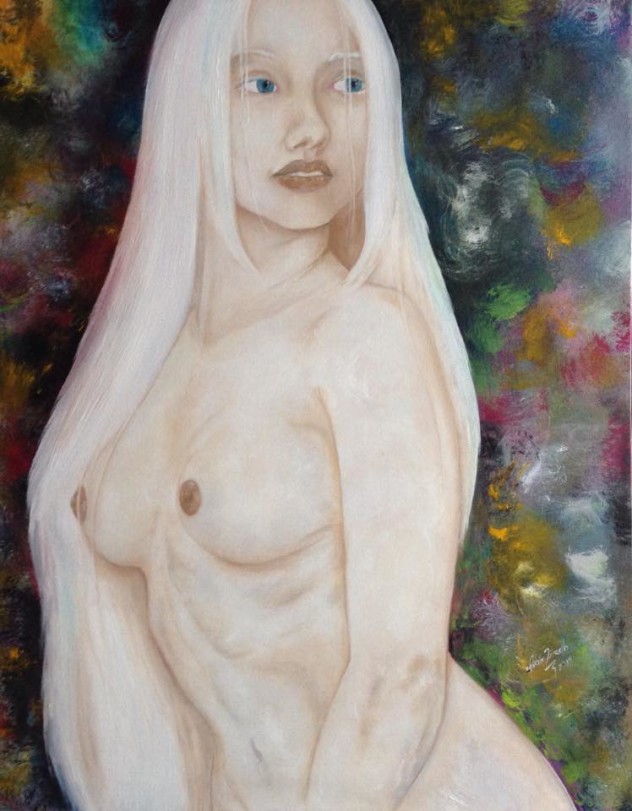 Sunday night I drew a sketch on a canvas. Monday morning I began a painting. Tuesday afternoon it was done. Each part of the process was great. One thing I can’t stretch enough is to maintain awareness of what’s going on in the process of creation and execution, and what goes on inside the mind. That awareness can transform the way an art piece is approached. It can also change the way an art moment is perceived. Such awareness brings also a greater connection with the work and the surroundings.
Sunday night I drew a sketch on a canvas. Monday morning I began a painting. Tuesday afternoon it was done. Each part of the process was great. One thing I can’t stretch enough is to maintain awareness of what’s going on in the process of creation and execution, and what goes on inside the mind. That awareness can transform the way an art piece is approached. It can also change the way an art moment is perceived. Such awareness brings also a greater connection with the work and the surroundings.
So, I did. From the time I began drawing I tried to study each moment. I reviewed my technique and provided closed attention to how I wanted to proceed to painting it. At that moment I had a good idea of what I wanted to do. To my surprise, the brush strokes began flowing better than I thought possible while I painted the background. The colors came together nicely. Once the colorful background was complete, I began working with the figure.
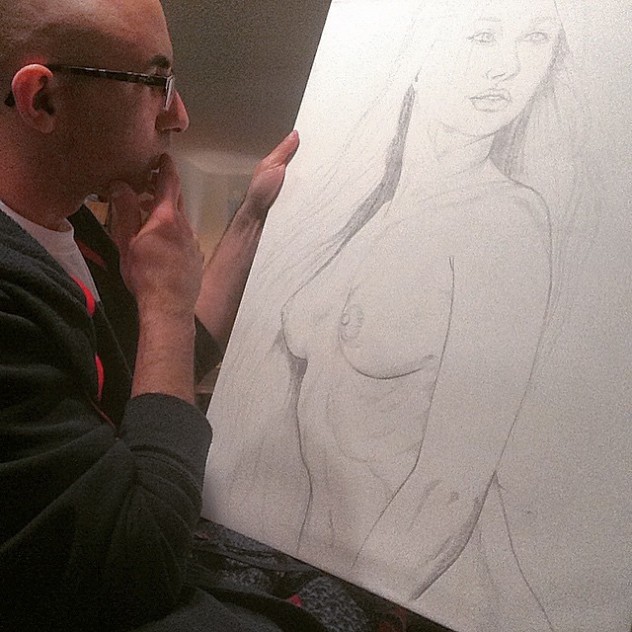 I tried to understand each shadow and each brush stroke leading to the shades I wanted to achieve. I was looking for an almost monochromatic figure and at the end it was accomplished. I wanted to pay close attention to the face and the detail of the eyes and I am very satisfied with the results. I really enjoyed working on this painting. I can’t stop staring at it, specially at the details. There is no title yet for this painting but I am considering working on a new painting following these steps. That is another upside of the awareness I mentioned before: by keeping track of the steps and technique it is possible to reproduce them in a new project. Now that the painting is ready for sale, I am ready to begin a new one.
I tried to understand each shadow and each brush stroke leading to the shades I wanted to achieve. I was looking for an almost monochromatic figure and at the end it was accomplished. I wanted to pay close attention to the face and the detail of the eyes and I am very satisfied with the results. I really enjoyed working on this painting. I can’t stop staring at it, specially at the details. There is no title yet for this painting but I am considering working on a new painting following these steps. That is another upside of the awareness I mentioned before: by keeping track of the steps and technique it is possible to reproduce them in a new project. Now that the painting is ready for sale, I am ready to begin a new one.


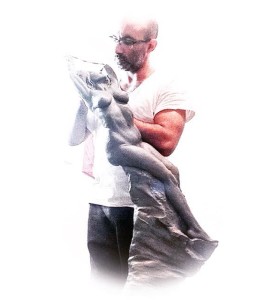 Oh, the delight of sculpting! Even when my hands are cramping after modeling the clay for so many hours and my body is slightly feeling the exhaustion there is nothing like seeing the sculpture take shape. Attempting to articulate the feeling of bliss I feel is almost futile. The experience is ethereal. Time seems to stop. The world fades away. The process transports me to a different place.
Oh, the delight of sculpting! Even when my hands are cramping after modeling the clay for so many hours and my body is slightly feeling the exhaustion there is nothing like seeing the sculpture take shape. Attempting to articulate the feeling of bliss I feel is almost futile. The experience is ethereal. Time seems to stop. The world fades away. The process transports me to a different place.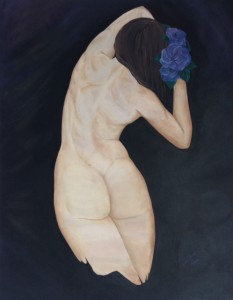

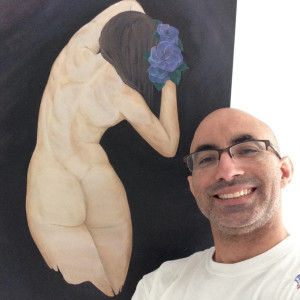 Detailing the muscles is very challenging but so much fun. I work one small area at a time and connect the muscles until the figure is complete. Hair comes after. To add a little something to the composition I added flowers this time. I was going in different directions with the flowers once I added the blue roses (which were originally purple) close to the head. First, and that was the original idea, I wanted to create a ‘u’ shaped frame of flowers and vines on the bottom half of the canvas. It was too much for me. The next idea was to just add a few flowers closing the figure at the bottom. I was not feeling it either, so I left it like that with just three blue roses. The rest is about cleaning up the details. After about 12 hours I was very satisfied with the result.
Detailing the muscles is very challenging but so much fun. I work one small area at a time and connect the muscles until the figure is complete. Hair comes after. To add a little something to the composition I added flowers this time. I was going in different directions with the flowers once I added the blue roses (which were originally purple) close to the head. First, and that was the original idea, I wanted to create a ‘u’ shaped frame of flowers and vines on the bottom half of the canvas. It was too much for me. The next idea was to just add a few flowers closing the figure at the bottom. I was not feeling it either, so I left it like that with just three blue roses. The rest is about cleaning up the details. After about 12 hours I was very satisfied with the result.
Intersubjective Artistic Matrix
For a while now I’ve been thinking about writing on a subject that for many artists may result in defensive argumentation, as I’ve seen in the past during some conversations and online discussions. However, it is a subject that deserves attention not to establish a definite interpretation of benefits or causes for rejection, but to understand the teaching and therapeutic benefits of engaging in this practice. In past posts, I explored the subject (read: How to Explain Your Art). During the summer I began reading the book Art Therapy and the Neuroscience of Relationships, Creativity, and Resiliency: Skills and Practices by Noah Hass-Cohen and Joanna Clyde Findlay, and they introduced to me the term “Intersubjective Artistic Matrix” (IAM). IAM defines the artist’s capacity to retain and explain the procedures utilized during the creation of a piece of art as if connecting subconscious and conscious processes.
In cognitive theory, knowledge is expressed in procedural fluency and conceptual understanding. How do we differentiate these two? There are many things we do without giving much thought. Certain procedures, with practice and repetition, become something like second nature to us. We know how to do it, so we just do it. At times, we find ourselves trying to explain what we are doing and fall short in putting into words all the elements and mental processes we often not pay attention to. Here is where conceptual understanding comes in. Conceptual understanding aligns connections and relationships between bits of information to create an explanation. Think of these two as practice and theory. There seems to be a debate about which of the two has more “knowledge value”. What if both are equally valuable? What if the context in which they are needed determines their value? What if both together are more valuable than each one of them separately? These are questions to be considered before rejecting one or the other. The more perspectives
We can expend time analyzing contexts where procedural fluency is required more than conceptual understanding, and the also the other way around. We might find contexts in which both are equally necessary. Nevertheless, the intention of looking at IAM is to seek understanding of when and how it becomes beneficial in the context of teaching and therapy. As an educator, and in my experience in the sculpting and painting parties, as well as in the classroom and private lessons, I find extremely important to have both. It could be counterproductive in a learning setting to do something for others to learn and not being able to explain the mental processes, and the procedures that interact in doing so. The opposite is also true. It is difficult to gain trust from the people we are trying to teach if we can explain all the nuances of a procedure but being incapable of doing it. Yes, there are some exceptions where it might not be necessary to prove we can do it, or situations in which we don’t have to explain what we are doing. Again, it all depends on the situation.
In therapy, and more specifically art therapy (I am not an art therapist although I had experience similar approaches within my classes) the benefits of this IAM is for the individual using art as a form of therapy. We can always try to interpret someone’s work based on our own understanding, knowledge, and biases. However, what if we could uncover the emotions and experiences from which the creation finds its inspiration and significance right from the source? What if the individual could find a way to open up to hidden emotions and experiences once expressed visually, through music, through writing, or other forms of art? Some might argue that art can speak by itself, but I can testify of how many interpretations of my art coming from other people have nothing to do with what I was thinking or feeling at the time of creation. Maybe we could give ourselves a chance to discover ourselves in our art, and allow others to do the same. Maybe someone else can find emotional and intellectual benefit in connecting process and concept if they are granted the chance to do so.